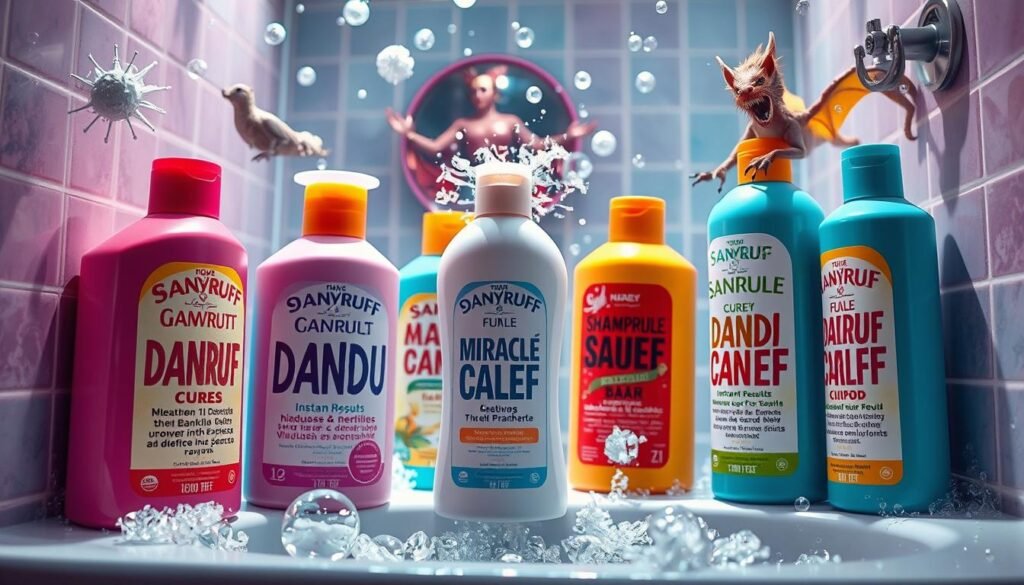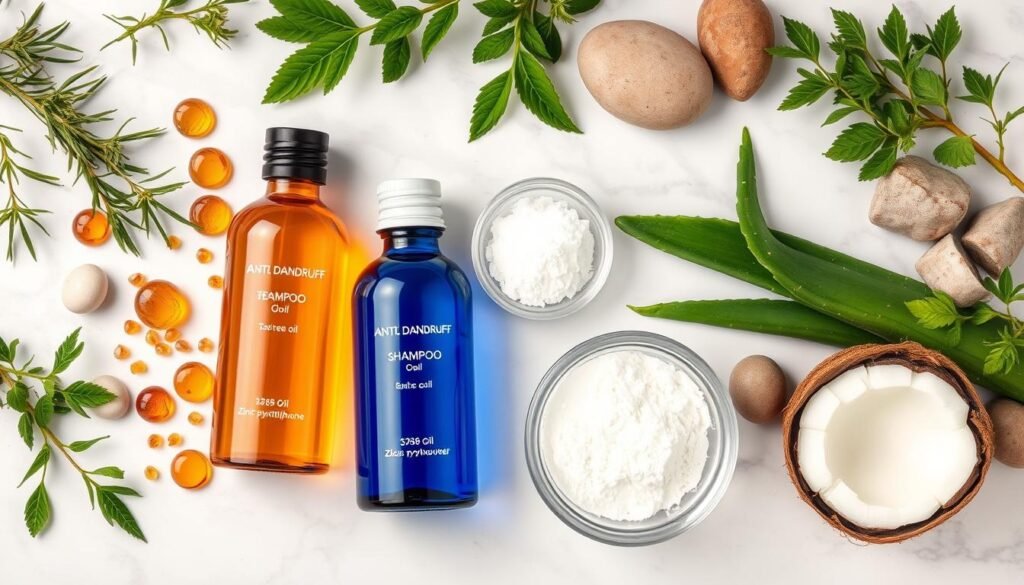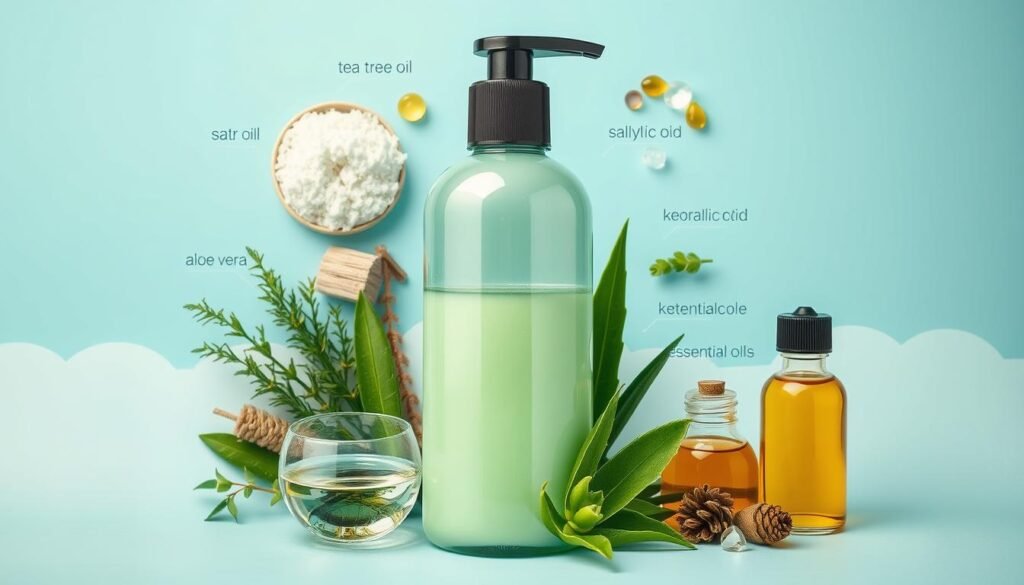Did you know about half the people with scalp problems think anti-dandruff shampoos could hurt their scalp? This wrong belief has made many turn to home remedies. But now, people want to know what’s in their shampoos. Brands like Head & Shoulders have noticed this. They made Bare, a shampoo with only nine ingredients. It shows a move to simpler recipes that focus on keeping the scalp healthy and fighting dandruff.
We’ll look at key shampoo ingredients for dandruff control in this article. We’ll also explore the best treatments around today. You’ll learn about effective ingredients and new natural options. This way, you can keep your scalp healthy and make smart choices about your hair care.
Key Takeaways
- Over half of those with scalp issues wrongly assume anti-dandruff shampoos can damage their scalp.
- Minimalist shampoo formulations, like Head & Shoulders Bare, are becoming increasingly popular.
- Effective dandruff treatments often contain powerful antifungal agents.
- Understanding ingredients can empower consumers to choose the right products for their needs.
- DIY scalp remedies are common, but they may not always be effective.
Understanding Dandruff and Its Causes
Dandruff is a common scalp issue that shows up as skin flakes and sometimes itching. Knowing the dandruff causes helps people control and avoid it. It can come from a dry scalp or too much skin oil.
Seborrheic dermatitis is related to dandruff and affects nearly half of all adults worldwide. It gives symptoms like oily flakes and red areas on the scalp. Men get dandruff more than women because their skin is oilier. This can cause too much malassezia yeast to grow. Teens often get dandruff because their oil glands are more active during puberty.
Other dandruff causes are stress, cold and dry weather, and some hair products with harsh chemicals. Keeping your scalp health good is important to stop these symptoms from getting worse. You might need to change how often you wash your hair. Or, you could find shampoos made for dandruff. Taking care of your scalp regularly, like moisturizing and gentle cleaning, is crucial.
For more healthy scalp tips, visit this resource. It gives good advice on scalp care and choosing products.
| Factor | Description |
|---|---|
| Oily Skin | Higher likelihood of dandruff due to excess sebum production. |
| Dry Scalp | Can lead to flaking and itching; different from oily dandruff. |
| Fungal Infections | Malassezia yeast overgrowth associated with oily skin can trigger dandruff. |
| Emotional Stress | Can exacerbate existing dandruff conditions. |
| Environmental Factors | Cold, dry conditions may worsen symptoms of dandruff. |
Knowing these factors lets people choose better hair care routines. And they can take steps to make their scalp health better.
Common Misconceptions about Dandruff Treatments
Many people think that anti-dandruff shampoos are bad for the scalp. But, research shows they’re safe and effective. The American Academy of Dermatology says using these shampoos twice a week is best.
Some believe that DIY remedies work better than store-bought shampoos. However, homemade mixes often miss key ingredients needed to fight dandruff’s causes. Also, dandruff isn’t just a winter or summer problem. It can happen all year due to various factors, like how humid it is or personal scalp conditions.
It’s important to understand the truth behind dandruff treatment myths. Flakes don’t always mean dandruff since other conditions can cause them too. For natural hair, using anti-dandruff shampoo once a week is advised by the American Academy of Dermatology. Finding the right routine for your hair is key.

To clear up dandruff myths, know that all scalps have fungi. A balanced scalp environment is vital for health. Flakes can also come from too much oil production. Thus, taking good care of your scalp, like regular cleaning, is crucial.
For more on dandruff myths, check out this resource. Knowing the facts helps you tackle dandruff with confidence.
Key Ingredients in Anti-Dandruff Shampoo
Anti-dandruff shampoos use special ingredients for scalp care to fight dandruff and keep hair healthy. They mix actives that tackle dandruff with moisturizers for better scalp health.
Zinc Pyrithione is a key ingredient in these shampoos. It’s an antifungal and antibacterial agent. It kills the bacteria and fungi that cause dandruff. Head & Shoulders uses Zinc Pyrithione in all its shampoos, making it a top choice in the fight against dandruff.
Selenium Sulfide is another important ingredient found in Head & Shoulders. It’s great for those with serious flaking, like seborrheic dermatitis. By fighting the Malassezia fungus, it offers lasting relief from dandruff.
Shampoos also have other ingredients to boost effectiveness. Moisturizers and conditioners keep hair soft and easy to manage. Preservatives keep the shampoo safe from germs, while fragrances and plant extracts like mint make it pleasant to use.
The table below outlines key ingredients commonly found in anti-dandruff shampoos, their functions, and benefits:
| Ingredient | Function | Benefits |
|---|---|---|
| Zinc Pyrithione | Antifungal and antibacterial | Kills bacteria and fungi contributing to dandruff |
| Selenium Sulfide | Antifungal | Reduces severe flaking and fights Malassezia fungus |
| Coal Tar | Slows down dead cell accumulation | Helps reduce flakes, especially for persistent dandruff |
| Salicylic Acid | Exfoliates and prevents clumping | Decreases scaling of dead cells on the scalp |
| Zinc Carbonate | Cleansing agent | Moisturizes the scalp and assists Zinc Pyrithione |
| Moisturizers | Conditioning | Ensures hair remains silky and tangle-free |
Knowing about anti-dandruff shampoo ingredients helps people pick the right products. It leads to healthier and dandruff-free hair.

Shampoo Ingredients to Fight Dandruff
Dandruff bothers millions, causing discomfort and shame. Knowing about effective ingredients helps fight it better. Zinc Pyrithione, Selenium Sulfide, and Ketoconazole are key. They offer unique ways to manage dandruff symptoms.
Zinc Pyrithione: The Proven Antifungal Agent
Zinc Pyrithione fights the Malassezia yeast which causes dandruff. It reduces scalp inflammation, smoothing it. Shampoos like Head & Shoulders use it for flake-free results.
Selenium Sulfide: How It Works to Reduce Flakes
Selenium Sulfide helps with severe dandruff, like seborrheic dermatitis. It slows skin cell turnover to lessen flakes. Using shampoos with this ingredient really improves scalp health.
Ketoconazole: A Broad-Spectrum Fungicide
Ketoconazole targets various fungi, improving scalp conditions. It’s key for dandruff and irritation relief. Products from MakingCosmetics Inc. prove its worth in dandruff care.

| Ingredient | Function | Target Conditions |
|---|---|---|
| Zinc Pyrithione | Antifungal | Dandruff, Scalp Inflammation |
| Selenium Sulfide | Antifungal, Cell Turnover Regulator | Severe Flaking, Seborrheic Dermatitis |
| Ketoconazole | Broad-Spectrum Fungicide | Fungal Infections, Dandruff |
These ingredients are a strong defense against dandruff, for all scalp needs. For more on anti-dandruff agents, check out ingredient effectiveness. Picking the right product mix is key for a healthy scalp.
Exploring Natural Ingredients for Dandruff Control
Looking for effective scalp care? Natural dandruff treatments are a great option. Many herbal remedies have shown success in reducing dandruff and improving scalp health.
Aloe Vera is known for its anti-fungal and antimicrobial powers. It not only reduces flakes but soothes the scalp too. This helps ease the discomfort that comes with dandruff.
Using coconut oil, particularly virgin oil, is another smart choice. It fights against the dandruff-causing fungus, Malassezia globosa, with its antifungal and antibacterial properties. It also moisturizes the scalp to prevent dryness and flaking.
Lemon juice is loaded with Vitamin C and fights dandruff with its citric acid. It keeps the scalp healthy and controls oil, reducing fungus growth.
Curd, or yogurt, has anti-inflammatory and antibacterial strengths. It feeds the scalp and stops irritation. Adding it to your hair routine can be very helpful.
Neem is great at battling fungal activity that leads to dandruff. Research backs up its ability to keep dandruff at bay. Camphor also fights dandruff with its antimicrobial features. It helps keep the scalp moist as well.
Adding these natural elements to your daily care can make your scalp healthier and lessen dandruff problems. Many people find long-term solutions in these herbal treatments instead of harsh chemicals.
Notable Synthetic Ingredients in Dandruff Shampoo
Knowing about synthetic ingredients helps improve scalp health. Many shampoos use them to fight common dandruff issues. We will look at three main synthetic ingredients in these shampoos.
Coal Tar: Its Role in Scalp Health
Coal Tar is a key ingredient in many synthetic dandruff solutions. It slows down how fast skin cells grow. This helps reduce scaling and scalp inflammation.
Using it twice a week can ease itching. It also helps remove skin buildup, making the scalp healthier.
Salicylic Acid: Exfoliating Benefits for the Scalp
Salicylic Acid is known for its ability to exfoliate. It removes dead skin cells, which helps manage flakes better. Adding Salicylic Acid to your care routine improves product effectiveness and keeps the scalp healthy.
Sulfur: The Ancient Solution to Dandruff
Sulfur is an old remedy for dandruff. Its antifungal traits offer a strong solution for dandruff issues. Using sulfur in daily hair care can lessen flakiness, both from old and new dandruff treatments.
For better hair care, mix these ingredients with tailored strategies. For cleansing tips, check this guide.
| Ingredient | Benefit | Recommended Usage |
|---|---|---|
| Coal Tar | Reduces scaling and inflammation | Twice a week |
| Salicylic Acid | Exfoliates dead skin cells | As needed |
| Sulfur | Antifungal properties | As part of regular routine |
The Rise of Minimalist Formulations in Dandruff Care
People are now choosing simpler products for their personal care routines. This shows a want for simple, effective solutions without extra stuff. In dandruff care, brands are creating products to meet these new wants.
Brands use natural ingredients like tea tree oil, aloe vera, chamomile, and peppermint in shampoos. These soothe the scalp and fight dandruff. They also use zinc pyrithione and salicylic acid for proven dandruff relief.
pH-balancing shampoos are gaining popularity. They keep the scalp’s natural pH level, reducing dryness and irritation. Also, brands offer custom formulas for different hair types, ensuring effective, personalized care.
The push for eco-friendly products shows the minimalist mindset too. Consumers like sustainable packaging, like recyclable materials or shampoo bars.
Products like the Intense Hydrating and Clarifying Shampoo stand out. It features ginger and other botanical extracts. Together with the Hair Boost Conditioner, it tackles oily scalp problems simply and effectively.
| Product | Key Ingredients | Target Issues |
|---|---|---|
| Intense Hydrating and Clarifying Shampoo | Ginger, Petitgrain, Witch Hazel, Lime, Bergamot, Rosemary | Oily hair and scalp |
| Hair Boost Conditioner | Argan Oil, Aloe Vera, Cinnamon Bark, Lavandin Grosso, Vitamin E | Nourishment and strengthening |
The minimalist trend in hair care makes routines simpler and more effective. It uses high-quality, natural ingredients. This approach not only meets the need for effective dandruff solutions but also supports a healthier grooming lifestyle.
Consumer Preferences and Market Trends
As people pay more attention to what they use, simple and effective hair care is in demand. Head & Shoulders BARE meets this need with only nine key ingredients. It suits those looking for clear, potent care solutions.
The Launch of Head & Shoulders BARE
Head & Shoulders BARE hits the mark by offering a simple solution that works. It appeals to those who value scalp health and product performance without unnecessary additives. The focus on what’s in the bottle attracts those wary of artificial chemicals.
Consumer Insights from Recent Studies
Recent findings show a move towards natural and earth-friendly hair care ingredients. This mirrors a wider interest in sustainable living and well-being. The popularity of zinc pyrithione and ketoconazole has boosted the demand for shampoos, both medicated and natural.
The anti-dandruff market, worth USD 4.5 billion in 2023, is expected to grow to USD 7.8 billion by 2032. This growth is fueled by more dandruff concerns and a focus on healthy scalps. With better online shopping, people can find products that fit their needs easily. For more details on these trends, click here.
Conclusion
Managing dandruff well means knowing about various ingredients. You have synthetic options like ketoconazole and salicylic acid. Natural remedies also play a big part. It’s key to understand these to pick the best products for you.
Salicylic acid is a standout ingredient. It’s in lots of shampoos, like Head & Shoulders. It helps by gently exfoliating the scalp. Plus, it fights fungal infections and keeps the scalp healthy. Adding such solutions to your hair care can change how you deal with dandruff.
Making smart choices about dandruff ingredients leads to a healthier scalp. When folks learn which products work best, they tackle their dandruff issues head-on. This means they’re on the path to healthier hair that lasts.